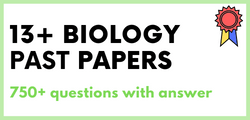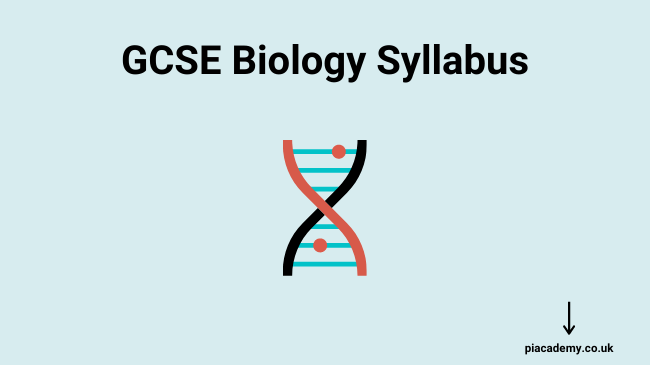In order to ensure that the students are progressing from key stage 3 to A level in the areas of knowledge and other skills, GCSE set out criteria for each subject. The GCSE syllabus is nothing but the criteria or the prerequisite skills the students are supposed to have before sitting the GCSE exam. Having said that, we at PiAcademy have made our attempt through this article to explain the syllabus and make it easy for the students and the parents to understand.
Introduction
We learn different aspects of life through different disciplines. Science progressively provides the basic foundation for understanding the material world. GCSE hence aims at making the students be able to study aspects like methods, processes and various uses of science.
GCSE BIOLOGY
GCSE Biology is concerned with the behaviours of different living organisms and their interactions with each other. GCSE Biology sets the criteria of what the students should be able to know and understand till key stage 3 i,e. before sitting the GCSE exam.
Divided into two papers, GCSE Biology covers the following topics-
- Cell biology
- Transport systems
- Health, disease and the development of medicines.
- Coordination and control.
- Photosynthesis.
- Ecosystems.
- Inheritance, variation and evolution
The prerequisites are thus dubbed as syllabus which is enumerated below point to point:-
1. Cell biology
Prokaryotic and eukaryotic cells
- Explain how the main subcellular structures of eukaryotic cells (plants and animals) and prokaryotic cells are related to their functions, including the nucleus/genetic material, plasmids, mitochondria, chloroplasts and cell membranes.
- Explain how electron microscopy has increased our understanding of subcellular structures.
- Explain the aseptic techniques used in culturing organisms.
Growth and development of cells
- Describe the process of mitosis in growth, including the cell cycle and explain the importance of cell differentiation.
- Describe cancer as the result of changes in cells that lead to uncontrolled growth and division.
- Describe the function of stem cells in embryonic and adult animals and meristems in plants.
- Discuss potential benefits and risks associated with the use of stem cells in medicine.
- Explain the role of meiotic cell division in halving the chromosome number to form gametes.
Cell metabolism
- Explain the mechanism of enzyme action including the active site, enzyme specificity and factors affecting the rate of enzymatic reaction.
- Describe cellular respiration as an exothermic reaction that is continuously occurring in all living cells.
- Compare the processes of aerobic and anaerobic respiration.
- Explain the importance of sugars, amino acids, fatty acids and glycerol in the synthesis and breakdown of carbohydrates, lipids and proteins.
2. Transport systems
Transport in cells
- Explain how substances are transported into and out of cells through diffusion, osmosis and active transport.
Transport systems in multicellular organisms.
- Explain the need for exchange surfaces and a transport system in multicellular organisms in terms of surface area: volume ratio.
- Describe some of the substances transported into and out of a range of organisms in terms of the requirements of those organisms, including oxygen, carbon dioxide, water, dissolved food molecules, mineral ions and urea.
Human circulatory system.
- Describe the human circulatory system, including the relationship with the gaseous exchange system, and explain how the structure of the heart and the blood vessels are adapted to their functions.
- Explain how red blood cells, white blood cells, platelets and plasma are adapted to their functions in the blood.
Transport systems in plants.
- Explain how the structure of xylem and phloem are adapted to their functions in the plant and how water and mineral ions are taken up by plants, relating the structure of the root hair cells to their function.
- Describe the processes of transpiration and translocation, including the structure and function of the stomata and explain the effect of a variety of environmental factors on the rate of water uptake by a plant, including light intensity, air movement and temperature.
3. Health, disease and the development of medicines
Health and disease
- Describe the relationship between health and disease
- Describe different types of diseases (including communicable and non-communicable diseases)
- Describe the interactions between different types of disease.
Communicable diseases
- Explain how communicable diseases (caused by viruses, bacteria, protists and fungi) are spread in animals and plants
- Describe a minimum of one common human infection, one plant disease and sexually transmitted infections in humans including HIV/AIDS
- Describe the non-specific defence systems of the human body against pathogens
- Explain the role of the immune system of the human body in defence against disease
- Describe how monoclonal antibodies are produced
- Describe some of the ways in which monoclonal antibodies can be used
- Describe physical plant defence responses (including leaf cuticle, cell wall) and describe chemical plant defence responses (including antimicrobial substances)
- Describe different ways plant diseases can be detected and identified, in the lab and in the field.
Treating, curing and preventing disease
- Explain the use of vaccines and medicines in the prevention and treatment of disease
- Describe the process of discovery and development of potential new medicines, including preclinical and clinical testing
- Explain how the spread of communicable diseases may be reduced or prevented in animals and plants, including a minimum of one common human infection, one plant disease and sexually transmitted infections in humans including HIV/AIDS.
Non-communicable diseases in humans
- Recall that many non-communicable human diseases are caused by the interaction of a number of factors. To include cardiovascular diseases, many forms of cancer, some lung and liver diseases and diseases influenced by nutrition, including type 2 diabetes
- Explain the effect of lifestyle factors, including exercise, diet, alcohol and smoking, on the incidence of non-communicable diseases at local, national and global levels
- Evaluate some different treatments for cardiovascular disease.
4. Coordination and control
Nervous coordination and control in humans
- Explain how the structure of the nervous system (including CNS, sensory and motor neurons and sensory receptors) is adapted to its functions
- Explain how the structure of a reflex arc is related to its function and how the main structures of the eye are related to their functions.
- Describe common defects of the eye and explain how some of these problems may be overcome
- Describe the structure and function of the brain and explain some of the difficulties of investigating brain function with some of the limitations in treating damage and disease in the brain and other parts of the nervous system.
Hormonal coordination and control in humans
- Describe the principles of hormonal coordination and control by the human endocrine system and the roles of thyroxine and adrenaline in the body, including thyroxine as an example of a negative feedback system
- Describe the roles of hormones in human reproduction, including the menstrual cycle and the interactions of FSH, LH, oestrogen and progesterone in the control of the menstrual cycle
- Explain the use of hormones in contraception and evaluate hormonal and nonhormonal methods of contraception and the use of hormones in modern reproductive technologies to treat infertility.
Plant hormones
- Explain how plant hormones are important in the control and coordination of plant growth and development, with reference to the role of auxins in phototropism and gravitropism and the effects of plant hormones, relating to auxins, gibberellins and ethylene.
- Describe some of the different ways in which people use plant hormones to control plant growth.
Homeostasis in humans
- Explain the importance of maintaining a constant internal environment in response to internal and external change
- Explain how insulin controls blood sugar levels in the body and how glucagon interacts with insulin to control blood sugar levels in the body
- Describe the function of the skin in the control of body temperature and the function of the kidneys in maintaining the water balance of the body
- Describe the effect of ADH on the permeability of the kidney tubules
5. Photosynthesis
Importance of photosynthesis
- Describe the process of photosynthesis and describe photosynthesis as an endothermic reaction
- Describe photosynthetic organisms as the main producers of food and therefore biomass for life on Earth
- Explain the effect of temperature, light intensity and carbon dioxide concentration on the rate of photosynthesis
- Explain the interaction of these factors in limiting the rate of photosynthesis.
6. Ecosystems
Levels of organisation within an ecosystem
- Describe different levels of organisation in an ecosystem from individual organisms to the whole ecosystem like how some abiotic and biotic factors affect communities.
- Describe the importance of interdependence and competition in a community.
The principle of material cycling
- Explain the importance of the carbon cycle and the water cycle to living organisms
- Recall that many different materials cycle through the abiotic and biotic components of an ecosystem
- Explain the role of microorganisms in the cycling of materials through an ecosystem
- Explain the effects of factors such as temperature and water content on the rate of decomposition in aerobic and anaerobic environments
- Evaluate the evidence for the impact of environmental changes on the distribution of organisms, with reference to water and atmospheric gases.
Pyramids of biomass and transfer through trophic levels
- Describe the differences between the trophic levels of organisms within an ecosystem and pyramids of biomass to explain, with examples, how biomass is lost between the different trophic levels
- Calculate the efficiency of biomass transfers between trophic levels and explain how this affects the number of organisms at each trophic level.
Biodiversity
- Describe how to carry out a field investigation into the distribution and abundance of organisms in an ecosystem and how to determine their numbers in a given area
- Describe both positive and negative human interactions within ecosystems and explain their impact on biodiversity and explain some of the benefits and challenges of maintaining local and global biodiversity.
Some of the biological challenges of increasing food yields using fewer resources
- Describe some of the biological factors affecting levels of food security including increasing human population, changing diets in wealthier populations, new pests and pathogens, environmental change, sustainability and cost of agricultural inputs
- Describe and explain some possible biotechnological and agricultural solutions, including genetic modification, to the demands of the growing human population.
7. Inheritance, variation and evolution
Reproduction
- Explain some of the advantages and disadvantages of asexual and sexual reproduction in a range of organisms.
The genome and gene expression
- Describe DNA as a polymer made up of two strands forming a double helix and the genome as the entire genetic material of an organism
- Explain the following terms: gamete, chromosome, gene, allele/ variant, dominant, recessive, homozygous, heterozygous, genotype and phenotype
- Describe simply how the genome, and its interaction with the environment, influence the development of the phenotype of an organism
- Discuss the potential importance for medicine of our increasing understanding of the human genome
- Describe DNA as a polymer made from four different nucleotides and recall a simple description of protein synthesis
- Explain simply how the structure of DNA affects the proteins made in protein synthesis and how genetic variants may influence phenotype; in coding DNA by altering the activity of a protein
- Describe how genetic variants may influence phenotype in non-coding DNA by altering how genes are expressed.
Inheritance
- Explain single gene inheritance and predict the results of single gene crosses
- Recall that most phenotypic features are the result of multiple genes rather than single gene inheritance
- Describe sex determination in humans
- Describe the development of our understanding of genetics including the work of Mendel.
Variation and evolution
- State that there is usually extensive genetic variation within a population of a species and recall that all variants arise from mutations and that most have no effect on the phenotype, some influence phenotype and a very few determine phenotype.
- Describe evolution as a change in the inherited characteristics of a population over time through a process of natural selection which may result in the formation of new species
- Explain how evolution occurs through natural selection of variants that give rise to phenotypes best suited to their environment.
- Describe the evidence for evolution, including fossils and antibiotic resistance in bacteria along with the work of Darwin and Wallace in the development of the theory of evolution by natural selection and explain the impact of these ideas on modern biology.
Selective breeding and gene technology
- Explain the impact of the selective breeding of food plants and domesticated animals by describing genetic engineering as a process that involves modifying the genome of an organism to introduce desirable characteristics
- Describe the main steps in the process of genetic engineering and explain some of the possible benefits and risks, including practical and ethical considerations, of using gene technology in modern agriculture and medicine.
GCSE Biology Foundation Tier as well as the Higher tier both adhere to the topics mentioned above.


















































